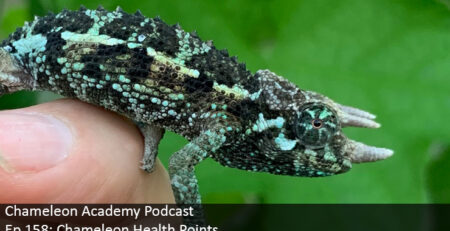Ep 171: Transitioning from the Chameleon Kit
Listen Here!


Bill Strand
ep 171: Transitioning from the Chameleon Kit
The ZooMed Chameleon Kit is one of the most common starting points for chameleon keepers. But one soon learns that it must be upgraded. Unfortunately, this isn’t always expected by the new keeper. And it must often be done with an urgency that requires guidance. In today’s episode I review the transition from the Chameleon Kit to the final cage set-up.
Informational Links
Creating an educational structure for the Chameleon Kit has been a huge job. You can link here to the resource here!
Transcript (more or less)
The Chameleon Kit from Zoo Med holds an infamous place in the chameleon community. It is the most commonly used cage for people just coming into the community due to the ease of carrying it at the retail level and the promised ease of having it all in one box. Although that promise is alluring, especially at the price it is offered, the dark side is that it truly is not an adequate cage set-up for most cases. Unfortunately, the consequences of using this cage kit inappropriately is serious sickness and death for the chameleon. Thus, we in the community devote an enormous amount of energy towards transitioning new keepers to their next cage set-up. This particular situation requires much more patience and finesse because the new keepers have been told that this is all they need. So they do not know the dangers in this cage kit and since they did all their research with the uniformed experts at the pet store they are leery of suddenly trusting random strangers on social media that come at them like rabid banshees telling them to spend more money.
This episode is about the transition from kit to forever home. This transition has three main parts
- Assess Chameleon Health
- Determine priority
- Execute as funds allow.
If you are a new keeper then you are in the right place to determine a sane and planned way forward. You probably got peppered with random advice snippets that you are not sure how to stitch together other than starting over. This podcast episode is primarily for you.
The secondary purpose of this episode is for experienced members of the community who wish to be part of helping new keepers go through the transition. This will give you a structure that will allow you to do it in an organized and effective manner.
I need to lay the ground work before we go forward. So here is a summary of the situation.
The Chameleon Kit is a bundled product from ZooMed. A bunch of parts were thrown together to provide something that pet stores could sell chameleons. You can tell it was an afterthought as the kit pieces do not go together. You have suction cups for a screen cage and plastic vines that have no place to be hung. You see these at the major pet store chains, reptile supply stores, and at reptile shows. It is the perfectly bundled and marketed product if you care more about getting a person out the door of your store rather than the long term health of the chameleon.
Now, to be fair, many of the items are useful, and with a couple additions, can provide an effective chameleon cage which can raise a healthy baby. Unfortunately, the kit maxes out at about 2.5” in chameleon snout-to-vent length. So this kit is effective for the couple months after you bring your chameleon home. Beyond that you have grown out of the gradients available. That wouldn’t be so bad if both the marketing on the box and the pet store advice were clear that this was a temporary solution. ZooMed actually says that when pressed. The problem is that people come away with the impression that this is all they need. Best of intentions aside, Whatever is going on between the customer asking for what they need and leaving the store or booth is that they are unaware that they will need to upgrade. And the number of them that come to us on social media with a chameleon that is already too big for the cage indicates that the good intentioned advisors are not starting off with the correct information to begin with. That is a separate problem that can fill much discussion time. For this episode let’s concentrate on the situation at hand which is a keeper who loves their chameleon and spent a healthy amount of money to get the set-up they have is now facing the realization that they will have to upgrade almost everything. Some are in a financial position to do so and only have to be proven that this new round of advisors know what they are talking about and some new keepers understand it, but do not have the budget to just replace everything right away. So, I am going to lead us through a systematic step by step transition where I explain why it needs to be changed and what the options are. I will pick the most basic and available equipment to provide the best transition target balance between cost and availability. There are any number of options out there and if you would like to explore them then more power to you! But I will present the emergency option for the worse case situation of the person whose chameleon needs to transition everything right now and the finances do not allow a single click ordering on day one.
The first thing to do when analyzing the situation is to evaluate the chameleon’s health. Does this chameleon need to go to the vet? It would be sad to fix the equipment and find out that the chameleon had a medical condition that needed treating.
There are three medical conditions most encountered in the Chameleon Kit situation.
- Metabolic Bone Disorder/Disease, often called MDB
- Respiratory Infection or RI
- Chronic Stress
Each has a varying level of urgency and seriousness. If you are a new keeper then find someone you trust and get an experienced eye on the situation. You can find briefs on these conditions on the Chameleonacademy.com/medical page to do some initial self-research. You’ll find pictures there to help you out. But nothing beats bringing on an experienced eye to your team.
Metabolic Bone Disorder, or MBD, is our layman’s term for nutritional secondary hyperparathyroidism (NSHP). This is where the chameleon does not get enough calcium in its body and its bones are rubbery, weak, and break easily. Imagine your skeleton not being hard. It wouldn’t be able to support your weight and the muscles would not have a solid anchor from which to work. This is a slow and painful death for your chameleon and sneaks up on the new keeper who doesn’t have a good reference as to what a chameleon should look like and happens over time so there aren’t always obvious warning flags. Calcium needs to be in the diet. And vitamin D3 needs to be in the body to allow that calcium to be absorbed. Add to that the necessity for Magnesium to be present, Phosphorus to be present, but in the right balance, and there to be the right amount of heat and water for the overall systems to run effectively. This is a specific danger with the Chameleon kit because vitamin D3 is synthesized in the chameleon’s skin by exposure to UVB light. The only area that the included reptisun 5.0 T5 13W Compact Fluorescent Lamp provides adequate UVB is, literally, for a couple inches starting 2 inches below the light and then it quickly fades uselessly into the dark cage. So the new keeper knows they need UVB and they have checked that box with the UVB light included, but there was nothing to tell them to affix the basking branch – or vine – in the correct position. So the UVB is there, but useless. And here is the tricky part. There is a way for the Chameleon kit to provide a proper environment for a chameleon if it is set up a certain way. I released a podcast last season explaining how to do this and I have tested it myself. I am currently on my third chameleon being raised in the Chameleon Kit using this UVB so I know it works. But it only works for a chameleon under 2.5” in body length. Beyond that and you are pushing the limits on a number of different parameters. And this is a valuable part of the transition – how long do you have and how can you extend that time to give yourself whatever time you need to find the equipment and funds. All of this information is in the show notes of course so when you have time take a look at the chameleonacademy.com website
MBD happens over time so we most often see this condition with keepers that have had their chameleon in the kit for a long time and they come to social media because they finally determine that something is off with their little guy. It may be falling out of branches or not being able to use his tongue. Unfortunately, by this time the condition is advanced. Although we can stop MBD from getting worse, we cannot reverse the damage already done. We can help you set up a hospital bin and get calcium into your chameleon’s system, but the best approach is to get under the personal care of an experienced reptile veterinarian who can guide the process.
So our first step is to do an MBD check on the chameleon. The first symptoms of MBD are joints looking like Us instead of Vs. Or legs bending in the middle where there should be solid bone. The chameleon has trouble holding itself up off the branch when it crawls and may not be able to aim its tongue properly. In advanced cases, the limbs have multiple breaks that happen over sloppily healed previous breaks. Sometimes the jaw is not strong enough to close and the tongue pushes out. If you are seeing the beginning of these symptoms then you need to act fast on the transition. If advanced, you need to work on a hospital bin. If you have a baby chameleon and are posting on social media after having him for a week the chances are low that you have an MBD problem just yet. It is after a month of two that you could start seeing symptoms. I say could because the Reptivite supplementation sample that is included in the kit does have dietary D3 and that will help bridge the gap. We don’t like to rely on supplementation because giving D3 dietarily can lead to overdose, but in the case of the Chameleon Kit that danger is greatly reduced. Reptivite does not have excessive levels of D3 so there is wiggle room in its use. There is your one silver lining here! If you are helping the transition for someone else do the MBD test to ensure that is not on your plate of challenges. Ask for pictures of the elbows to look for unnatural bends, ask for a video of the chameleon walking across the cage, and get a close up of the jaw. If no MBD then breathe a sigh of relief and let’s go on to respiratory infections.
A respiratory infection happens when the body’s immune system is compromised and weakened to the point where the bacteria that is always around looking for an entry point, is able to breach the defenses and start a colony. The signs that you are dealing with a respiratory infection are lethargy, eyes closed during the day, napping, the nose pointed into the air, and sitting with their mouth open. The insidious thing with these infections is that your chameleon will do everything possible to hide their illness so you only see it when it has gotten so bad that they can’t hide it any more. Their eyes are their most powerful defense against being eaten and they keep watch every day of their lives for predators. So when they are napping during the day they are feeling so bad inside that they are willing to get eaten rather than open their eyes. This is why we moderators freak out when someone posts a picture of their chameleon with their eyes closed. And it is all we can do not to sound like a lunatic when we gently post an inquiry as to what is going on. This is an immediate trip to the veterinarian to get antibiotics. That is the only thing that will save your chameleon’s life. I know, you hear about the wonders of Manuka honey and other home remedies. And the miraculous recoveries attributed to them. I’ll not weigh in other than to say you don’t have time to experiment. Get to the vet ASAP and get antibiotics. Is this an emergency? Yes. The sooner you catch it the more of a chance you can beat it. But it is not easy and especially not easy if the chameleon is a baby or wild caught or in a stressful situation at home. Bottom line, if the chameleon ever closes its eyes during the day treat it like an emergency. I know you think it is an overreaction. You can quote me as saying it is not an over-reaction. As soon as you see signs of respiratory infection you have to trust that you saw it. Because your little guy will act all healthy hyped up on adrenaline at the vet’s office and you’ll be sent home with nothing to worry about. If you see eyes closed or an experienced member sees signs of a respiratory infection you’ll have to insist or else you’ll be starting much further along in the infection by time your little guy cannot muster the healthy act when taken to the vet. And what causes Respiratory infections and why would we specifically be looking out for these with the Chameleon Kit? Welcome to our third health check – chronic stress.
There are two types of stresses. Stress spikes and Chronic stress. Stress spikes are being taken out of the cage and given a visual examination, shown for a couple of minutes to the neighborhood kids, and a hawk flying over head. Stress spikes are harmless because they come and go. Chronic stress is the killer. This is when they are held and played with for a long period of time This is when they are housed with another chameleon. This is when the cage does not offer enough foliage for them to feel secure. And all of these things add up to the point where the immune system is weakened. Now you are seeing the connection to the above respiratory infections. If you have a respiratory infection the antibiotics are only a temporary fix until you remove the cause of stress. If you do not have a respiratory infection then this step is preventative. The signs of a discontent chameleon are many and it really helps to have an experienced person to help out. Some common signs are constant crawling on the screen like they just can’t feel safe. Or constant cowering in a corner as if they are scared of something which can be as frightening as the family cat or as hideous as a certain color plastic bag. It could be the ceiling fan. This is detective time. Keeping more than one chameleon in the same cage is a huge long term killer of chameleons. If someone says you can keep chameleons together seriously reconsider purchasing from them. This will kill your chameleons. I know, there are some advanced keepers that bend these rules. You will kill a lot of chameleons before you get to that level. Get there first and then you can play footloose and fancy free with the husbandry rules. Even if you do not see signs of stress, but there are common stressors that are pointed out, like ceiling fans, cohabitation, the sun through the window, and AC vent above the cage, a cat or bird nearby…take care of them proactively. And yes, seeing the world through your chameleon’s eyes is a whole new world and a whole new language to learn. It does not come easy.
Giving your chameleon a sense of security in a screen cage which is too small will be a challenge. If your chameleon is feeling threatened his sense of safety will be when he can hide in foliage. This means that there needs to be enough plants inside for him to feel like he is hidden. And with a screen cage where he can be seen from all angles this becomes a tall order. But there are things that you can do. I absolutely love this idea I got from Uli nunn. When she has the people she is working with remove all their fake plants from inside the cage to be replaced by living plants she has them hang all the fake plants along the outside of the cage to provide a visual barrier. If you block the sight path of the chameleon you block the attack path of the predator as far as your chameleon is concerned. I have accomplished this by attaching pieces of PVC or coroplast to the side of the cage. Anything that blocks their view will calm them down. You can also try raising their cage up above your head level. Chameleons are very visual animals. Block the number of sides that they have to keep watch at and they calm down. Put them above all the action and they will calm down. So these are some tricks of the trade. Though, just a note, if you block the line of sight through the side of the cage, don’t place the cage where you will be suddenly appearing at the front of the cage as you walk by and freaking the poor guy out because of you surprising him.
Of course, there could be any number of medical issues other than these, but, for your initial checklist, these will cover the majority of what we see coming in. You can get right on to the equipment transition, but that must be in parallel with treating the medical condition or there will be no chameleon left to enjoy your final cage.
When we get to the transition of equipment, the two biggest items that need to be changed are the cage and lighting system. It is fashionable to switch out the UVB light as the top priority, but the T5 systems available will overpower the small Chameleon Kit cage. For example, the Arcadia 12% T5 in a ProT5 fixture can put out higher UVB at the screen top than has ever been recorded on Earth in nature. You can test this yourself. A UVI of 43 is the highest measured on Earth on a volcano in Bolivia. A ProT5 12% can clock out UVI 50 at the screen top. Allowing your baby chameleon to crawling on the screen top and expose their belly to this radiation is scary. But this is what is done day in and day out because of a general lack of understanding of UVB strength.
Ideally, you would upgrade both cage and lighting fixture at the same time. There are many combinations of cages and lighting systems that work. The one that does a very nice balance between economics, availability, and functionality is the combination of a Reptibreeze XL which is a 24” x 24” x 48” screen cage, a vivosun quad T5 fixture, and an Arcadia 6% UVB bulb. Of course, I have links to all of these in the show notes.
Here is the point where some insight into how the product works will help you determine the urgency of the transition. You are able to make the kit work for chameleons under 2.5” in snout to vent length. If the chameleon is that small then it is a relatively simple matter to set up the cage as described in the show notes. It doesn’t mean that you call it a day. Even if this is the case, it won’t be long before the chameleon grows to 2.5”. It just means that you do not have to panic buy. It is always good to know the urgency of each piece of the transition so that you can make rational decisions when faced with things such as financial constraints or equipment shortages. Can you wait two weeks for the item to come back into inventory, or is it urgent enough that you go to plan B? There is power in understanding the urgency. You are able to set a realistic priority list.
If you can upgrade only one at a time then I would upgrade the lighting system first. You can make a powerful lighting system work with the small cage by suspending it above the cage a few inches. In the case of a 6% bulb I suggested above, yes, it is quite high measured at the top of the screen, but you quickly get into the reasonable range. So if you are putting the bulb directly on the cage top this is the bulb to go with. If you are electing to go with a 12% bulb then definitely check into the strength with your Solarmeter. I keep my 12% bulbs four to six inches above my cage tops. They are my favorite bulb because of how big the UVI 3-6 range is, but they are just over powering if you put them directly on the top of the cage.
In any of these case makes sure the cage has a thick foliage layer to provide an escape from the UVB. And here is where you have to be smart about adding a powerful UVB bulb to the Chameleon Kit. There is limited space and limited options. Make sure that the cage has a dense foliage layer that allows the chameleon to get out of the UVB. And I am meaning dense enough to block that light. T5 bulbs are very powerful. They are meant to punch down to reach a bearded dragon at the bottom of a cage. Not for a chameleon inches below. So we have to be smart about how we use this tool. The plastic plant sprig included in the kit is not sufficient for blocking this light! You need a dense plant coverage for protection. The smaller the cage the more difficult it is to get the right plants in there so you’ll have to be creative. Take a look at the pictures in the show notes to get an idea of what it takes.
In summary, if you are upgrading the UVB, but not the cage, make sure the chameleon has an easy way to get out of the UVB light. Once you get the larger cage this becomes an easier task.
Now, considering I am producing this episode smack dab in the middle of the Covid pandemic, we have had unpredictable supply issues. So what if you can get the cage, but not the UVB bulb? This is where we have to take stock of everything that we have at our disposal to make this work. In this case, it is simple to set the kit UVB compact fluorescent to work by making sure your chameleon’s back is 2 inches below the bulb. But what if the casque of your male veiled chameleon is now rubbing the top panel screen? If your chameleon is over 2.5” in snout to vent length it is difficult to find a working balance. In this case it is time to fall back on that Reptivite with D3. Using this every feeding can make up for what he isn’t getting through UVB. Reptivite has 10k IUs/lb of D3 which is half of what you get with Repashy Calcium Plus and just a bit more than what you give with Repashy Calcium Plus LoD. So it is well within the reasonable range and the danger of overdose with D3 is low. Unfortunately, this may cause issue with Jackson’s Chameleons and other supplementation sensitive species and they may develop edema. We are still getting to the bottom of how that works. But hopefully the dependance on dietary D3 is a temporary condition until you get the final UVB bulb and fixture. And I use Reptivite with D3 as my example because that is the sample that is included in the kit and might be what they bought to replace the small amount included. If you have taken the role of transition guide then you can use the supplementation schedule you are familiar with as long as it is inline with the group you are part of. I actually don’t like Reptivite that much because it includes extra phosphorus. That doesn’t work so well when we are using it on crickets that are already so high with phosphorus. As important as it is for us to keep calcium and phosphorus in balance, adding phosphorus is going in the wrong direction. So I would actually encourage moving on from there. Plain calcium every feeding and Repashy Calcium Plus LoD as the multivitamin is a good regimen. If you need to do a vitamin D3 bridge due to insufficient UVB then Repashy Calcium Plus is a good one to bring in. A number of panther breeders use Calcium plus every feeding so our confidence in its safety is high.
My personal preference is the Arcadia brand products EarthPro-A and RevitaliseD3, but they are designed for systems which have a strong UVB system so if you transition to them use the Repashy Calcium Plus as your D3 bridge if you are concerned about the amount of UVB that the chameleon is able to get.
Now, I want to bring up a consideration that is just a hypothesis and we are still working on figuring out. There are some experiences and reports that suggest that switching between supplementation regimens may cause some edema. Keepers are quick to place blame on one or the other supplements, but when other keepers have used them long term it just doesn’t hold water. A gradual transition over a month or so is a good idea. But you do what is necessary depending on the situation. If you haven’t noticed, this podcast isn’t really good at laying down black and white directions. I offer understanding and hope to create a generation of thinking keepers and advisors!
So let’s summarize our steps.
- Evaluate the chameleon’s medical condition and act accordingly
- Stabilize the situation and make sure the kit set-up they have is as good as it can be to get through the transition.
- Determine the priority of the transition depending on the size of the chameleon, the funds available, and the equipment availability.
So there is a little structure here. Some checkboxes. But the fact is that you can only be slightly effective if you don’t understand the pieces. If you have a knee jerk reaction that everytime you are faced with the Chameleon Kit you tell them to get T5 UVB lighting and then you do a self-congratulatory victory lap the chameleon may be dying from a respiratory infection or may now have the added stress of being blasted by UVB because there isn’t any cover in the cage. A little knowledge is a dangerous thing. And social media has made it very easy for people to pick up snippets of information and then broadcast those snippets outside of context. I would like very much to create a generation of advisors that have context. Each situation will have common elements, but will also be different. Please treat them as such.
The onslaught of the Chameleon kit does not appear to be slowing down. In fact, it will start to get worse. I am seeing other companies putting together kits which may not be much better. So buckle up Chameleon wranglers, we have an adventure ahead of us. It is easy to say things like CFLs give off no UVB or that the Chameleon Kit is a death kit. That is fine. These over generalizations get the point across. But if you are dedicated to chameleon husbandry enough that you are willing to sit through podcast episodes then you are the type of chameleon husbandry artisan that we need to bring insight and perspective to the community. You are the type of person we need to jump in when someone shows up with the Chameleon Kit or one of the many knock offs coming our way and approach this new keeper with empathy and kindness. This is more than just an opportunity for you to show off how much you know. This is an opportunity for you to help someone take their first steps into the next chapter of their chameleon keeping experience. And it isn’t an easy transition because it is a splash of cold water in the face that there even is a transition necessary. And this is why it is so hard. It is more than just memorizing the talking points. It is treating each person that comes to us as a new story. We do Chameleon kit transitions multiple times a week. That is why I am putting so much effort into these resources. But the new keeper has no idea about this and is coming in fresh. They did their research as far as they know and have arrived. It is like finally getting up to the top of the hill and they are about to see that here is another mountain peak behind it that is even steeper to climb. The community needs advisors and mentors that are willing to step in, unjaded, and gently guide the new keeper through the transition.
So, this is my part. I am producing resources and information. Keep an eye on the chameleonacademy.com website as there are a number of resources I am working on. Releasing this podcast is actually just one of the items on my checklist and is just part of a much bigger picture. So there is much more to come to prepare us for being more effective in helping new keepers with this very important transition. This is a long term condition. Of course, everything we learn going through this process will be applicable across the board. If you are adept at personalizing the Chameleon kit transition to each individual case that comes to you then you will have developed a rare skill. Instead of having a mob milling about looking for new keepers to “process”, I’d like to see a cadre of chameleon husbandry artisans constantly on the look out for new chameleon kit keepers so they can practice their skill at pulling out the nuances of the situation and personalizing the experience.
I just completed giving a five week Chameleon Kit Zoom class for influencers across the groups and the various social media platforms. I learned a lot from going through that process and am working on refining the materials. When I have bolstered up the materials, I will do another class round and open it up to people who resonate with my vision of what we can be as a community. So, keep watching the Chameleon Academy social media for announcements.
In other news, we are quickly coming to the end of season five of the Chameleon Academy Podcast. We have about two more episodes after this. I traditionally take a couple months off between seasons. This gives me time to refresh. Although it always takes the form of working on different projects so there really isn’t down time involved! I am not sure what I would do with downtime anyway. I don’t work well with downtime. I am excited to spend this time growing the chameleonacademy.com resources, refining the Chameleon kit Transition Guide course work, and developing some other ideas so we can hit the ground running in 2021.













